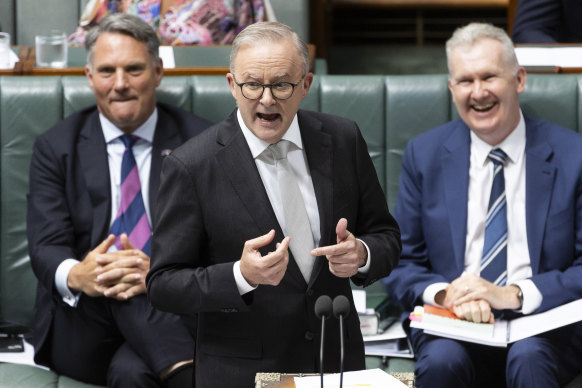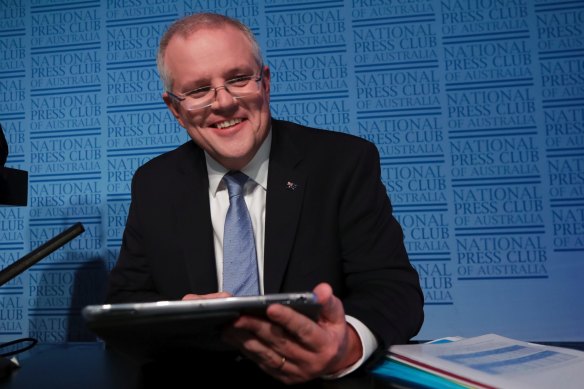- Analysis
- Politics
- Federal
- Income tax
This was published 1 year ago
The creep never ends. Both sides know more tax cuts are needed
By Shane Wright
The original stage 3 tax cuts were never going to end bracket creep. The government’s rejigged stage 3.0 tax cuts are not going to end bracket creep.
Whichever party wins the next election, and the election after that, and the one after that, will have to deliver personal income tax cuts of some sort.

Prime Minister Anthony Albanese has talked up the government’s tax plan in parliament. But more tax cuts will be needed.Credit: Alex Ellinghausen
There are two problems about the whole issue of the tax cuts and what they mean to future taxpayers. One problem is the ignorance about the very meaning of “bracket creep”, and the other is that neither the government nor the opposition is being upfront about the federal budget’s growing reliance on personal income tax.
When the original seven-year tax plan was announced by then treasurer Scott Morrison in his 2018-19 budget, he declared it was all about “protecting what Australians earn from bracket creep”.
Axing the entire 37 per cent tax bracket meant, he said, that most working Australians would “likely never face a higher marginal tax rate through their entire working life”.
But bracket creep is not all about your higher marginal tax rate. The term gets used by those who want a flatter, less progressive tax system but are afraid to admit it.
Tax boffins use the term “fiscal drag” as that covers the small proportion of people who move into another tax bracket every year plus far more who pay a greater share of their income in tax even though they stay in the same bracket.
Under both the original stage 3 and Prime Minister Anthony Albanese’s stage 3.0, the average tax rate for all Australians will grow over the next decade. In other words, bracket creep is not dead, buried or cremated but continuing on, alive and well.
Under the original stage 3, the abolition of the 37 per cent rate meant people earning between $45,000 and $200,000 fell into the 30 per cent marginal tax rate. They would pay $5092 in tax on their income up to $45,000, and then 30 per cent of every dollar between that point and $200,000.
Someone on $70,000 would pay $12,592 in tax, or 18 per cent of their income. If they got a 4 per cent pay rise, taking their annual wage to $72,800, their tax bill would climb to $13,432 or 18.5 per cent of their income.
A 4 per cent pay rise means a half percentage point jump in the share of their income going to the taxman. That’s bracket creep.
Most attention has been paid to the impact of bracket creep on high-income earners. But under the original stage 3, it was those on $45,000 (who didn’t receive a tax cut at all) who got burnt the most by bracket creep.
Someone on $25,000 paid just 5.2 per cent of their total income in tax. By $30,000, the rate had climbed to 7.5 per cent, and at $45,000 it was at 11.3 per cent. Just a little bit of extra income meant a steep increase in a person’s average tax rate.
By contrast, the average rate on someone earning $200,000 reached 25.6 per cent, just 1.6 percentage points higher than the person on $150,000.
Neither the Morrison stage 3 nor the Albanese stage 3.0 ended bracket creep. We know this because of work done by the independent Parliamentary Budget Office.
In its analysis of the budget, it found average income tax rates fell when the original stage 3 started in mid-2024. But by 2025, the average rates started to climb. By 2030, the average tax rate for all Australians was back to where it was before stage 3 and by 2034 the average was at an all-time high of 27.1 per cent.
Low and middle-income earners were going to be hurt the most.
Albanese’s stage 3.0 has been attacked because over a decade it will raise $28 billion more than the Morrison plan. All of this increase comes at least five years from now and is due to stronger-than-expected wages growth and the retention of the 37 per cent tax rate.
Labor’s plan does reduce bracket creep on lower-income earners far more than under the original plan, but it has been cute in trying to hide the broader impact on all people. The government’s own analysis focuses on someone on the “average wage” (which today is about $73,000).
Their average tax rate falls below 20 per cent under stage 3.0, far lower than under the original plan. But by the end of this decade, under the rejigged arrangements, the average tax rate on this average wage earner will have climbed to 21.9 per cent (as opposed to 22.7 per cent under the original plan).
Once we hit the middle of next decade, the tax take on the average wage is expected to have reached 23.6 per cent. Under the original Morrison plan, it would have been at 24.3 per cent.

Then treasurer Scott Morrison promised in 2018 that his tax plan would end bracket creep – but it was never going to do that. Credit: Alex Ellinghausen
So even under the government’s plan, and with its selective focus on an average wage, the tax take increases. Not only does the average tax rate climb under both tax plans, so does the federal budget’s dependence on income tax.
Under both, income tax will reach an all-time high of 13.4 per cent of GDP by the middle of next decade. It’s currently about 12.6 per cent, itself a record high, but will fall as the tax cuts start.
That dependence on tax is contributing to the cost-of-living problems being experienced by most Australians as their tax bill climbs.
About the only effective way to stop the average tax rates of all Australians reaching Everest-like levels is to index thresholds to inflation (as occurred for a short period under Malcolm Fraser) or the wage price index.
The other is to deliver tax cuts just ahead of a federal election, an approach every government since Fraser’s has adopted.
Peter Dutton has promised some undefined tax package for the next election. Unless he promises a huge tax overhaul or unpopular deep cuts in spending, such a package could only be modest and one that will give back some bracket creep, but not all of it.
Anthony Albanese is focused on getting his plan bedded down while fending off attacks over his honesty.
Neither position is tenable. Fiscal drag will just continue.
Cut through the noise of federal politics with news, views and expert analysis. Subscribers can sign up to our weekly Inside Politics newsletter.